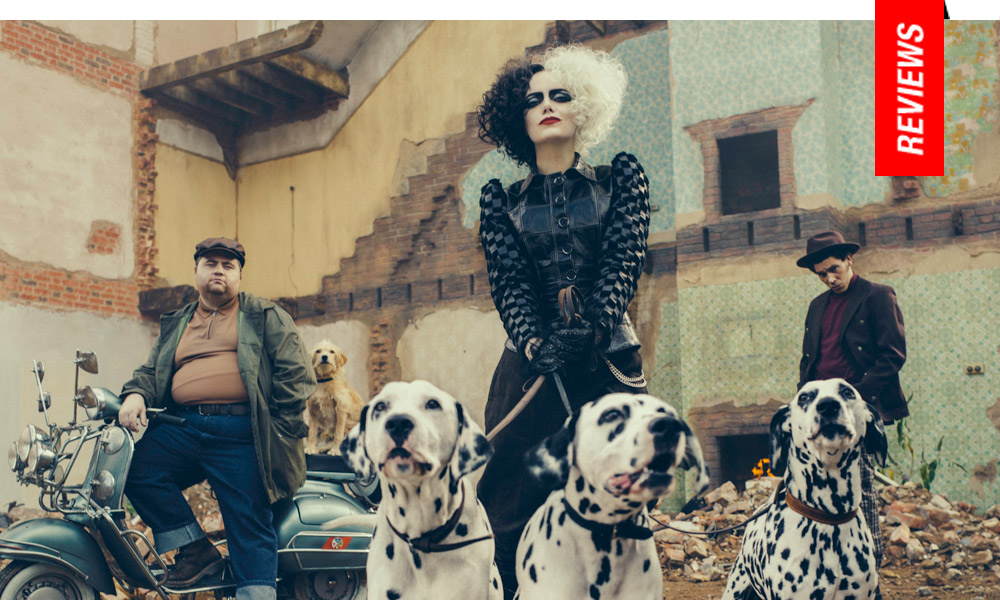Cruella Intentions: Gillespie Recuperates Another Villainess in Perky Origin Story
In a world where nearly every studio feature is irrevocably neutered in an effort to appeal to everyone (and end up as merely an ambivalent, piece of debris floating about the ether for the consumption of completists or eternal dilettantes), Gillespie’s offering (penned by Dana Fox and Tony McNamara, and tying in to the utmost periphery of Dodie Smith’s One Hundred and One Dalmatians) rides high on the swagger of Emma Stone, who exudes warmth and compassion while travelling the trauma to her dark side.
Estella (Tipper Seifert-Cleveland) is marked at birth with a striking coif of black and white hair, split down the middle. Raised by her single mum Catherine (Emily Beecham), she’s an immediate pariah at school as a young girl, partly for her look but also for her irascible nature as a rabble rouser, especially for 1964’s standards of femininity. Her mother coins her daughter’s wayward behavior as alter ego Cruella to be a playful moniker to describe Estella’s tendencies, which finds the girl expelled from school.
Believing London will be a better fit for the girl’s talents, who has a penchant for design, Catherine makes a clandestine visit to the Baroness (Emma Thompson), a famed designer who holds annual galas at her secluded seaside manor, Hellman Hall. But the secretive meeting ends in tragedy, with Estella witnessing her mother’s death, forcing her to flee to London as an orphan. Sleeping on the fountain of Regents Park, she meets two other homeless children, Jasper and Horace, who quickly form a trio of fast fingered grifters. Ten years pass and Estella (now Emma Stone) is gifted an opportunity by Jasper (Joel Fry) and Horace (Paul Walter Hauser, donning a similar persona as his I, Tonya character) to work in a custodial capacity at the swank department store, Liberty of London. A chance mishap a la Mannequin catches the eye of the cruel and imperious Baroness, who hires Estella as a designer. But the proximity to the manipulative fashionista leads Estella to embrace her Cruella and embark on a path of vengeance in her mother’s memory. Along the way, she recruits impassioned designer Artie (Joel McCrea) as a devoted sycophant who assists in her insidious self-actualization.
Ironically, Cruella tends to recuperate its infamous antagonist by merely displacing the malevolence onto a wan template of the woman she’s destined to become (a resulting symbiosis to which are tied plot twists deepening the film’s stance on nature vs. nurture, mothers vs. daughters, truth vs. kindness, etc.). But unlike something like Maleficent, Gillespie doesn’t shy away from pointing the narrative compass away from villainy, setting up a franchise tentpole while also indicating Cruella de Vil has only just begun to explore the warped parameters of her psyche. Unfortunately, the set-up plays like The Devil Wears Cruella, with female mentorship in the fashion world unleashing another harpy caricature into the world in the form of Emma Thompson’s ill-conceived Baroness.
Without any attempt to provide this harridan with any depth, Thompson’s performance and character represent the sort of exploitation born out of Whatever Happened to Baby Jane?’s horror hag cycle. Thompson, who appears to be leaning into a series of unlikeable authoritarians (following 2019’s Late Night), extremely talented actor though she is, doesn’t quite conjure the malevolence and grotesque beauty of women like Glenn Close, Sigourney Weaver, Michelle Pfeiffer or Anjelica Huston, all who could have navigated more interesting facets than this plasticine script allows for the Baroness (though as Estella, Stone conjures a semblance of Pfeiffer as Selina Kyle, worth mentioning). Somehow, Thompson’s performance, occupying a space wherein the actual subversion of these narratives usually exists, ends up being the film’s major blemish.
DP Nicolas Karakatsanis (who has lensed several Michael R. Roskam features) elevates the film beyond mere CGI-frenzy (computer generated canines, including roided out Dalmatians which have Pitbull bodies and would have been more enjoyable realized as Cerberus), for the most part, and Gillespie gives credit where credit is due (a snippet of the throaty Tallulah Bankhead in Hitchcock’s 1944 classic Lifeboat points to where Cruella’s inspiration came from).
Jenny Beavan’s sumptuous fashion designs also bolster the film’s considerable visual offerings, and while Stone’s make-up as Cruella often looks like Tim Burton’s version of Harley Quinn, it has its own transitional evolution (by her final scene, Stone’s purr is so smooth she’s a shoo-in for a Lizabeth Scott biopic). A sometimes-spastic soundtrack selection feels like Sofia Coppola gone haywire, but for the most part, this adds to the film’s pop power (perhaps no more effectively than a punk performance to The Stooges). Whatever the case may be, Cruella is often infectiously entertaining despite its faults, and reframing Cruella de Vil as a devious stunt queen, at least for the briefest sparkle of a few moments, feels sublime.
★★★½/☆☆☆☆☆
